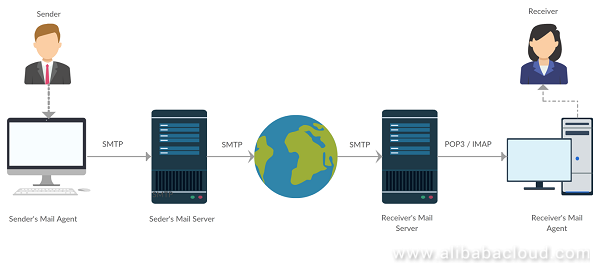By Sai Sarath Chandra, Alibaba Cloud Tech Share Author. Tech Share is Alibaba Cloud's incentive program to encourage the sharing of technical knowledge and best practices within the cloud community.
The electronic mail, better known as email, is one of the most widely used invention of the modern age. In fact, the email was created much earlier than the Internet. It is an important invention that has not faded in popularity; enterprises and businesses across the globe still use emails as the official channel of communication.
Let's look at the brief history of email? Back in the 1960s, there was no reliable medium to transfer or exchange the information. There were already multiple SMTP protocols, but none of them were reliable enough to be used to transfer critical information. Email was also developed using the SMTP protocol.
Initially, email was used only for transferring plain text messages in encoded format between two parties through a unique address. Also during that time, the email was only intended for military applications, some universities and corporate research laboratories. Later on, there were a lot of improvements made in terms of reliability as well as several other features.
In the 1980s, we started seeing applications with proper implementation of SMTP protocol as the internet became more accessible to the general users. In the 1990s, millions of people discovered the email and signed up for an inexpensive personal account. Advertisers also found this to be an inexpensive medium to reach large audiences. Unfortunately, with the growing popularity of email, some advertisers started flooding users' inboxes with large amounts of messages to promote their product, which is now known as "spam". Because of this, ISPs and email providers have developed several methods to reduce spam, including keyword filters, sender signature verification, DNS level blocking, and many more.
Fast forwarding to the 2010's, email still remains popular. Email is often considered as the official medium between organizations and individuals to record and communicate any formal work. It is an inexpensive and accurate medium of communication between two different parties. There are also several systems that can efficiently manage emails to keep the mailboxes clean.
Let's look at some advantages and disadvantages of email over other communication methods:
Advantages
Disadvantages
Ok, enough with the basics. Let's now discuss the underlying protocols of email in detail, starting with SMTP.
SMTP stands for simple message transfer protocol. It is a naive protocol and is very simple to understand and use. The original specifications are published under RFC 821 in 1982. It has been revised many times, and you will see lot more features and specifications added under RFC 5321.
SMTP protocol is an application layer protocol in the OSI Model. When a user logs in to an email server, a TCP connection between the client and the server is established. When the mail server receives a TCP connection, it initiates a connection on port 25 by default. Once the connection is made successfully, information will be exchanged between the sender and receiver.

User-Agent: A user agent refers to the mail client at both sender and receiver ends. A mail client can be anything like Thunderbird, Microsoft Outlook, and web clients like Gmail.
Let's see how this email travels all the way from the sender to receiver:
At any point in time, the receiver can open his/her mail client and read the incoming mail.
In addition to SMTP, there are two other commonly used protocols for emails, which are POP3 and IMAP.
POP stands for post office protocol. The digit next to it is just to denote the version of POP. POP simply says that once a message is received by the client, then that message will be deleted from the server. This means that you can access an incoming mail only from a single device. If you want to access the mail from multiple devices, then you should explicitly mark the mail so that it would not be deleted from the server. The main advantage of POP is that the server will not be overwhelmed by message storage; the storage limited only by the capacity of your device.
IMAP stands for internet message access protocol. This protocol has all the features of what POP has. However, unlike POP, IMAP was made to have the emails available across multiple devices. If you receive an email using one client, you can still see the message on a different device because your mailboxes will be automatically synchronized.
Once big advantage that IMAP provides is the ability to log into multiple clients. In addition to mail storage, the mail read/unread statuses will be synchronized across all clients. However, this may present an increased load onto the mail server due to the increased storage space until you explicitly clear them up/user deletes the emails.
Ok, great. We have just discussed the high-level overview of the SMTP protocol. Although there is a lot more to it than what we discussed here, we will not dive into the details in this article. Setting up your mail server manually requires a lot of resources and time for both testing and setting it up.
Instead, you can leverage the services such as Alibaba Cloud DirectMail to set up your own official mail server, which greatly reduces the effort and time to get your email up and running. You can also take advantage of other security products provided by Alibaba Cloud on top of DirectMail to make it more secure.
Let's take a look at the details of Alibaba Cloud DirectMail service and its benefits.
DirectMail was originally developed for Alibaba's own e-commerce platforms, which includes servicing Alibaba's record-breaking annual sales festival, Singles' Day. Tens of millions of emails are sent every day through DirectMail by Alibaba and Alibaba Cloud customers.
DirectMail guarantees stable and high conversion rates across various mail channels. Emails can be sent to the product console, API interface, and SMTP interface.
Stable and Scalable
Fast and Accurate
Multiple Mail Types
Highly Cost-effective
You can also get the sample SMTP reference for other programming languages like Python Perl, Ruby, Node.js, and Go. You can also use Alibaba Cloud Resource Access Management feature to allocate specific rights to additional users to access a console for managing the mail server.
Ultra Low Latency and High Performance Deep Learning Processor with FPGA

2,598 posts | 770 followers
FollowAlibaba Clouder - August 29, 2018
Alibaba Cloud Indonesia - December 28, 2022
Alibaba Clouder - May 20, 2019
Alibaba Clouder - May 15, 2018
Alibaba Clouder - June 5, 2018
Alibaba Clouder - December 14, 2017

2,598 posts | 770 followers
Follow DirectMail
DirectMail
A simple and efficient email service to help you send transactional notifications and batch email
Learn More Domains
Domains
Over 20 million domain, free WHOIS privacy protection.
Learn MoreMore Posts by Alibaba Clouder
Start building with 50+ products and up to 12 months usage for Elastic Compute Service
Get Started for Free Get Started for Free